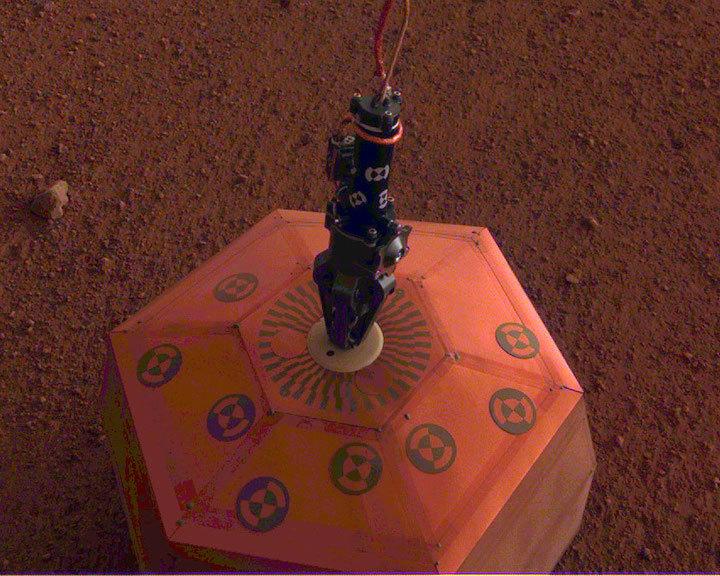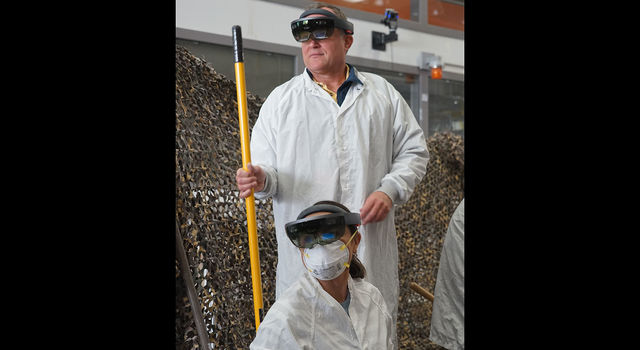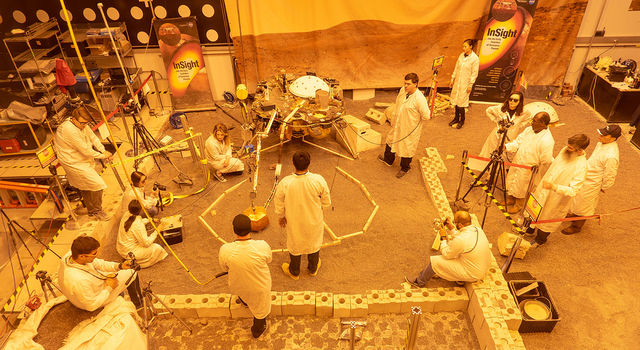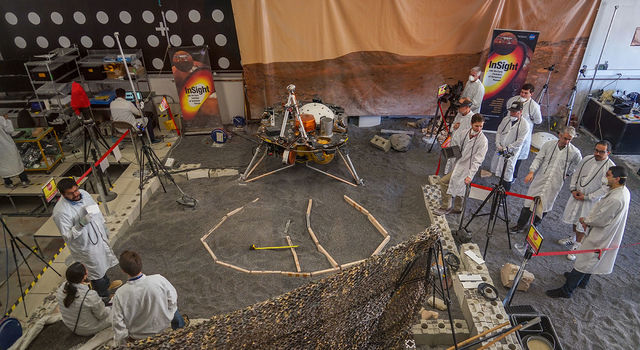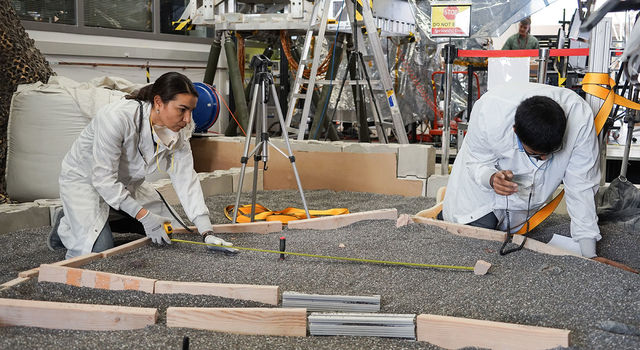8.12.2018
NASA InSight Lander 'Hears' Martian Winds
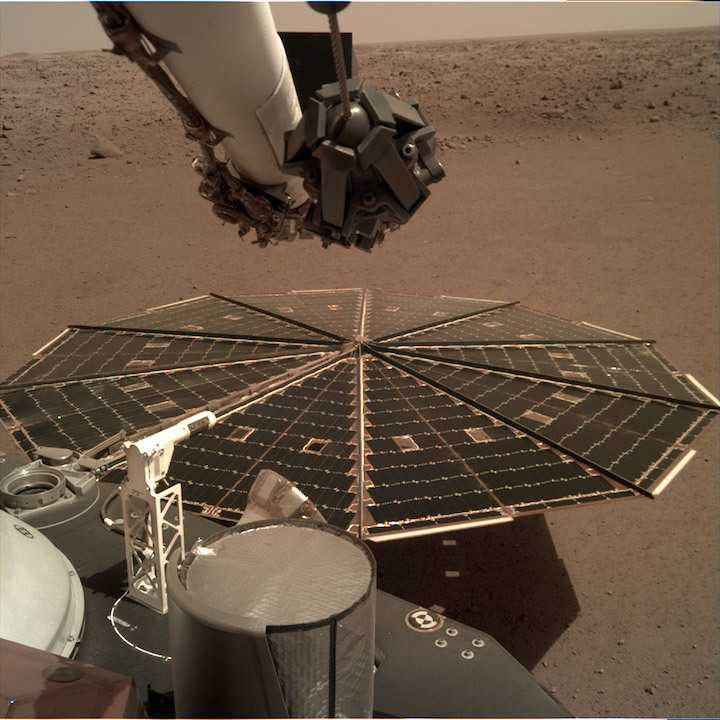
NASA InSight Lander 'Hears' Martian Winds
NASA's Interior Exploration using Seismic Investigations, Geodesy and Heat Transport (InSight) lander, which touched down on Mars just 10 days ago, has provided the first ever "sounds" of Martian winds on the Red Planet. A media teleconference about these sounds will be held today at 12:30 p.m. EST (9:30 a.m. PST).
InSight sensors captured a haunting low rumble caused by vibrations from the wind, estimated to be blowing between 10 to 15 mph (5 to 7 meters a second) on Dec. 1, from northwest to southeast. The winds were consistent with the direction of dust devil streaks in the landing area, which were observed from orbit.
"Capturing this audio was an unplanned treat," said Bruce Banerdt, InSight principal investigator at NASA's Jet Propulsion Laboratory (JPL) in Pasadena, California. "But one of the things our mission is dedicated to is measuring motion on Mars, and naturally that includes motion caused by sound waves."
Teleconference audio and accompanying visuals will stream live on NASA's website. A follow-along page is available at:
https://www.nasa.gov/insightmarswind
Two very sensitive sensors on the spacecraft detected these wind vibrations: an air pressure sensor inside the lander and a seismometer sitting on the lander's deck, awaiting deployment by InSight's robotic arm. The two instruments recorded the wind noise in different ways. The air pressure sensor, part of the Auxiliary Payload Sensor Subsystem (APSS), which will collect meteorological data, recorded these air vibrations directly. The seismometer recorded lander vibrations caused by the wind moving over the spacecraft's solar panels, which are each 7 feet (2.2 meters) in diameter and stick out from the sides of the lander like a giant pair of ears.
This is the only phase of the mission during which the seismometer, called the Seismic Experiment for Interior Structure (SEIS), will be capable of detecting vibrations generated directly by the lander. In a few weeks, it will be placed on the Martian surface by InSight's robotic arm, then covered by a domed shield to protect it from wind and temperature changes. It still will detect the lander's movement, though channeled through the Martian surface. For now, it's recording vibrational data that scientists later will be able to use to cancel out noise from the lander when SEIS is on the surface, allowing them to detect better actual marsquakes.
When earthquakes occur on Earth, their vibrations, which bounce around inside our planet, make it "ring" similar to how a bell creates sound. InSight will see if tremors, or marsquakes, have a similar effect on Mars. SEIS will detect these vibrations that will tell us about the Red Planet's deep interior. Scientists hope this will lead to new information on the formation of the planets in our solar system, perhaps even of our own planet.
SEIS, provided by France's Centre National d'Études Spatiales (CNES), includes two sets of seismometers. Those contributed by the French will be used once SEIS is deployed from the deck of the lander. But SEIS also includes short period (SP) silicon sensors developed by Imperial College London with electronics from Oxford University in the United Kingdom. These sensors can work while on the deck of the lander and are capable of detecting vibrations up to frequencies of nearly 50 hertz, at the lower range of human hearing.
"The InSight lander acts like a giant ear," said Tom Pike, InSight science team member and sensor designer at Imperial College London. "The solar panels on the lander's sides respond to pressure fluctuations of the wind. It's like InSight is cupping its ears and hearing the Mars wind beating on it. When we looked at the direction of the lander vibrations coming from the solar panels, it matches the expected wind direction at our landing site."
Pike compared the effect to a flag in the wind. As a flag breaks up the wind, it creates oscillations in air pressure that the human ear perceives as flapping. Separately, APSS records changes in pressure directly from the thin Martian air.
"That's literally what sound is — changes in air pressure," said Don Banfield InSight's science lead for APSS from Cornell University in Ithaca, New York. "You hear that whenever you speak to someone across the room."
Unlike the vibrations recorded by the short period sensors, audio from APSS is about 10 hertz, below the range of human hearing.
The raw audio sample from the seismometer was released unaltered; a second version was raised two octaves to be more perceptible to the human ear — especially when heard through laptop or mobile speakers. The second audio sample from APSS was sped up by a factor of 100, which shifted it up in frequency.
An even clearer sound from Mars is yet to come. In just a couple years, NASA's Mars 2020 rover is scheduled to land with two microphones on board. The first, provided by JPL, is included specifically to record, for the first time, the sound of a Mars landing. The second is part of the SuperCam and will be able to detect the sound of the instrument's laser as it zaps different materials. This will help identify these materials based on the change in sound frequency.
JPL manages InSight for NASA's Science Mission Directorate in Washington. InSight is part of NASA's Discovery Program, which is managed by NASA's Marshall Space Flight Center in Huntsville, Alabama. Lockheed Martin Space in Denver built the InSight spacecraft, including its cruise stage and lander, and supports spacecraft operations for the mission.
A number of European partners, including CNES and the German Aerospace Center, support the InSight mission. CNES and the Institut de Physique du Globe de Paris provided SEIS, with significant contributions from the Max Planck Institute for Solar System Research in Germany, the Swiss Institute of Technology in Switzerland, Imperial College and Oxford University in the United Kingdom, and JPL. DLR provided the Heat Flow and Physical Properties Package (HP3) instrument, with significant contributions from the Space Research Center of the Polish Academy of Sciences and Astronika in Poland. Spain's Centro de Astrobiología supplied the wind sensors.
Los Alamos National Laboratory in New Mexico and Institut de Recherche en Astrophysique et Planétologie in France are responsible for delivering the SuperCam instrument to NASA. The SuperCam microphone is provided by Institut Supérieur de l'Aéronautique et de l'Espace, a French higher education institution.
+++
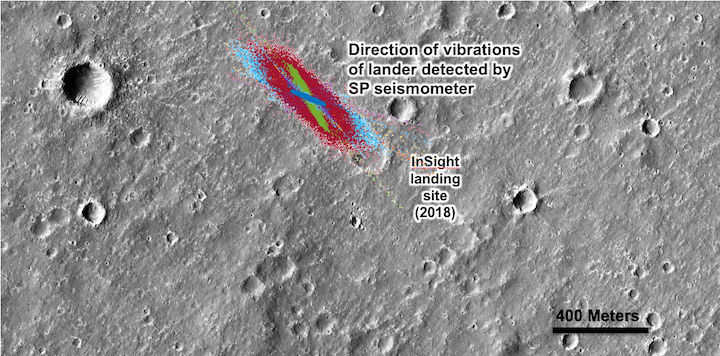
Of Wind and Dust Devils on Mars

Vibrations from InSight's First 20 Minutes on Mars
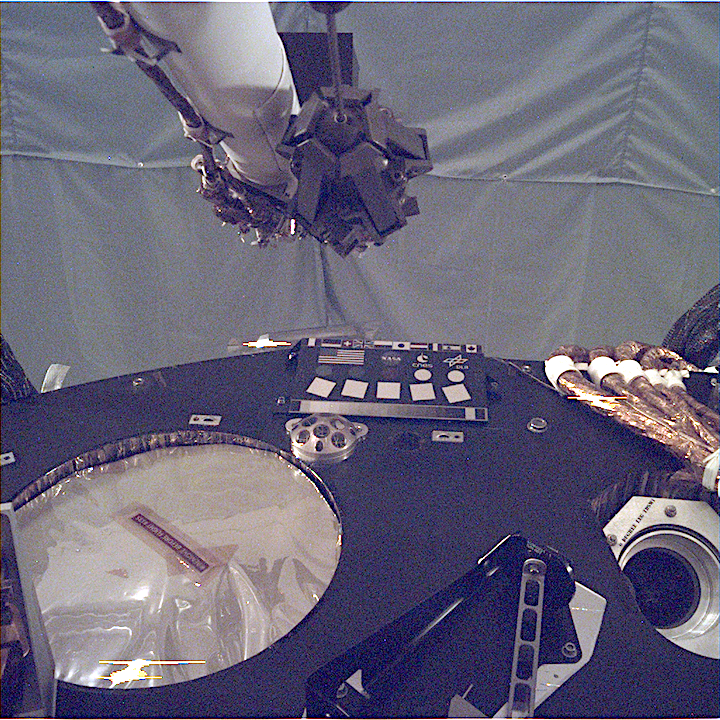
Test Image of InSight Deck and Calibration Target Before Launch
Quelle: NASA
----
Update: 12.12.2018
.
NASA's InSight Takes Its First Selfie

This is NASA InSight's first full selfie on Mars. It displays the lander's solar panels and deck. On top of the deck are its science instruments, weather sensor booms and UHF antenna. The selfie was taken on Dec. 6, 2018 (Sol 10).
The selfie is made up of 11 images which were taken by its Instrument Deployment Camera, located on the elbow of its robotic arm.
Those images are then stitched together into a mosaic.
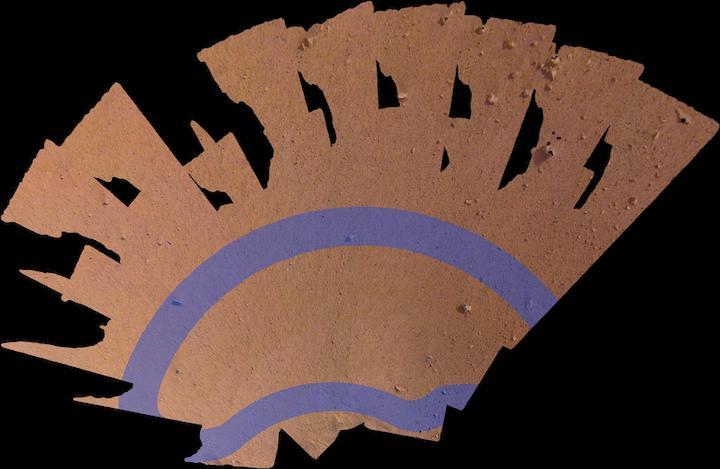
This mosaic, made of 52 individual images from NASA's InSight lander, shows the workspace where the spacecraft will eventually set its science instruments. The workspace is roughly 14 by 7 feet (4 by 2 meters). The lavender annotation shows where InSight's seismometer (called the Seismic Experiment for Interior Structure, or SEIS) and heat flow probe (called the Heat Flow and Physical Properties Package, or HP3) can be placed.
An unannotated version is also available.
JPL manages InSight for NASA's Science Mission Directorate. InSight is part of NASA's Discovery Program, managed by the agency's Marshall Space Flight Center in Huntsville, Alabama. Lockheed Martin Space in Denver built the InSight spacecraft, including its cruise stage and lander, and supports spacecraft operations for the mission.
JPL manages InSight for NASA's Science Mission Directorate. InSight is part of NASA's Discovery Program, managed by the agency's Marshall Space Flight Center in Huntsville, Alabama. Lockheed Martin Space in Denver built the InSight spacecraft, including its cruise stage and lander, and supports spacecraft operations for the mission.
NASA's InSight lander isn't camera-shy. The spacecraft used a camera on its robotic arm to take its first selfie - a mosaic made up of 11 images. This is the same imaging process used by NASA's Curiosity rover mission, in which many overlapping pictures are taken and later stitched together. Visible in the selfie are the lander's solar panel and its entire deck, including its science instruments.
Mission team members have also received their first complete look at InSight's "workspace" - the approximately 14-by-7-foot (4-by-2-meter) crescent of terrain directly in front of the spacecraft. This image is also a mosaic composed of 52 individual photos.
In the coming weeks, scientists and engineers will go through the painstaking process of deciding where in this workspace the spacecraft's instruments should be placed. They will then command InSight's robotic arm to carefully set the seismometer (called the Seismic Experiment for Interior Structure, or SEIS) and heat-flow probe (known as the Heat Flow and Physical Properties Package, or HP3) in the chosen locations. Both work best on level ground, and engineers want to avoid setting them on rocks larger than about a half-inch (1.3 cm).
"The near-absence of rocks, hills and holes means it'll be extremely safe for our instruments," said InSight's Principal Investigator Bruce Banerdt of NASA's Jet Propulsion Laboratory in Pasadena, California. "This might seem like a pretty plain piece of ground if it weren't on Mars, but we're glad to see that."
InSight's landing team deliberately chose a landing region in Elysium Planitia that is relatively free of rocks. Even so, the landing spot turned out even better than they hoped. The spacecraft sits in what appears to be a nearly rock-free "hollow" - a depression created by a meteor impact that later filled with sand. That should make it easier for one of InSight's instruments, the heat-flow probe, to bore down to its goal of 16 feet (5 meters) below the surface.
About InSight
JPL manages InSight for NASA's Science Mission Directorate. InSight is part of NASA's Discovery Program, managed by the agency's Marshall Space Flight Center in Huntsville, Alabama. Lockheed Martin Space in Denver built the InSight spacecraft, including its cruise stage and lander, and supports spacecraft operations for the mission.
A number of European partners, including France's Centre National d'Études Spatiales (CNES) and the German Aerospace Center (DLR), are supporting the InSight mission. CNES and the Institut de Physique du Globe de Paris (IPGP) provided the Seismic Experiment for Interior Structure (SEIS) instrument, with significant contributions from the Max Planck Institute for Solar System Research (MPS) in Germany, the Swiss Institute of Technology (ETH) in Switzerland, Imperial College London and Oxford University in the United Kingdom, and JPL. DLR provided the Heat Flow and Physical Properties Package (HP3) instrument, with significant contributions from the Space Research Center (CBK) of the Polish Academy of Sciences and Astronika in Poland. Spain's Centro de Astrobiología (CAB) supplied the wind sensors.
Quelle: NASA
----
Update: 14.12.2018
.
Mars Reconnaissance Orbiter spots InSight on Mars. Amazing picture. NASA/JPL-Caltech/University of Arizona picture.

Quelle: NASA
+++
Mars InSight Lander Seen in First Images from Space
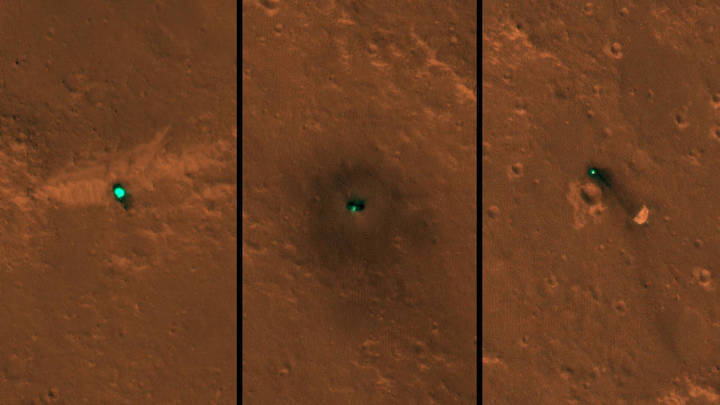
On Nov. 26, NASA's InSight mission knew the spacecraft touched down within an 81-mile-long (130-kilometer-long) landing ellipse on Mars. Now, the team has pinpointed InSight's exact location using images from HiRISE, a powerful camera onboard another NASA spacecraft, Mars Reconnaissance Orbiter (MRO).
The InSight lander, its heat shield and parachute were spotted by HiRISE (which stands for High Resolution Imaging Science Experiment) in one set of images last week on Dec. 6, and again on Tuesday, Dec. 11. The lander, heat shield and parachute are within 1,000 feet (several hundred meters) of one another on Elysium Planitia, the flat lava plain selected as InSight's landing location.
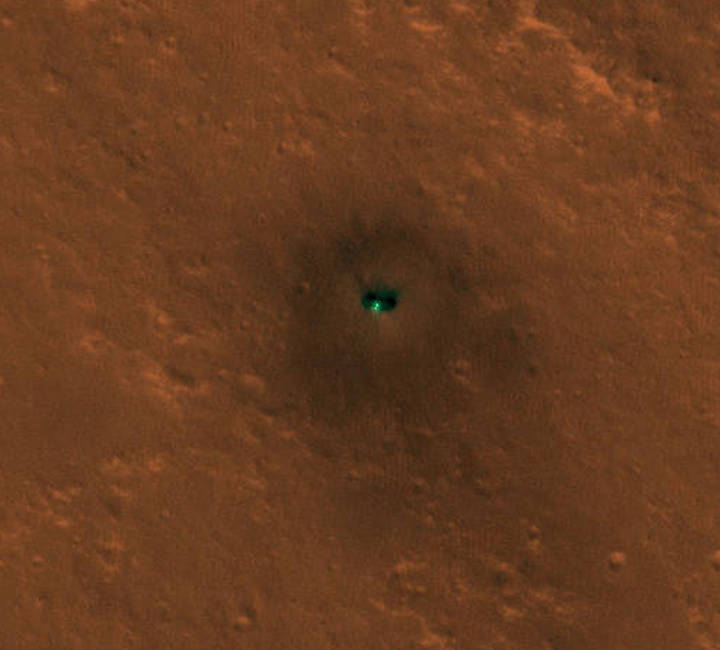
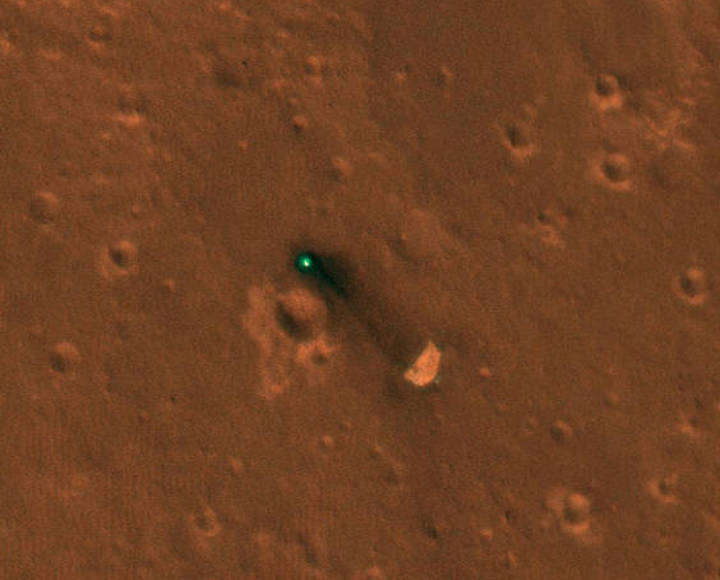
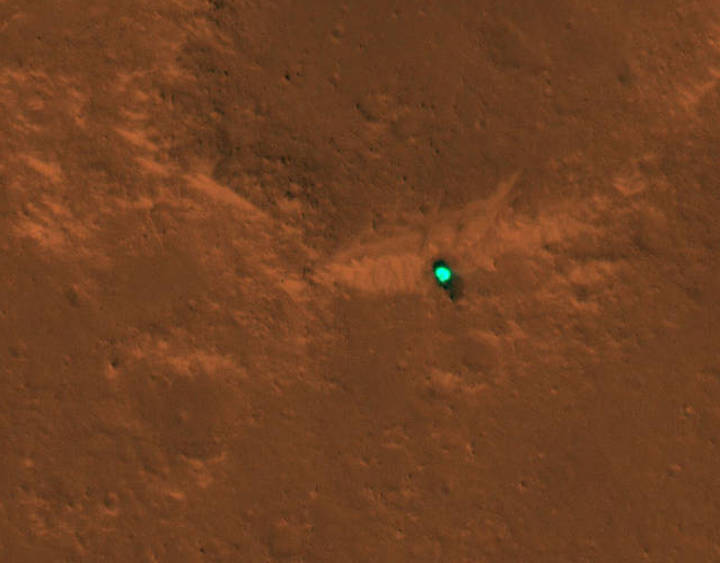
In images released today, the three new features on the Martian landscape appear teal. That's not their actual color: Light reflected off their surfaces causes the color to be saturated. The ground around the lander appears dark, having been blasted by its retrorockets during descent. Look carefully for a butterfly shape, and you can make out the lander's solar panels on either side.
This isn't the first time HiRISE has photographed a Mars lander. InSight is based largely on 2008's Phoenix spacecraft, which the camera aboard MRO captured on the surface of Mars as well as descending on its parachute. While the HiRISE team at the University of Arizona also tried to take an image of InSight during landing, MRO was at a much less opportune angle and wasn't able to take a good picture.
About InSight
JPL manages InSight for NASA's Science Mission Directorate. InSight is part of NASA's Discovery Program, managed by the agency's Marshall Space Flight Center in Huntsville, Alabama. Lockheed Martin Space in Denver built the InSight spacecraft, including its cruise stage and lander, and supports spacecraft operations for the mission.
A number of European partners, including France's Centre National d'Études Spatiales (CNES) and the German Aerospace Center (DLR), are supporting the InSight mission. CNES and the Institut de Physique du Globe de Paris (IPGP) provided the Seismic Experiment for Interior Structure (SEIS) instrument, with significant contributions from the Max Planck Institute for Solar System Research (MPS) in Germany, the Swiss Institute of Technology (ETH) in Switzerland, Imperial College and Oxford University in the United Kingdom, and JPL. DLR provided the Heat Flow and Physical Properties Package (HP3) instrument, with significant contributions from the Space Research Center (CBK) of the Polish Academy of Sciences and Astronika in Poland. Spain’s Centro de Astrobiología (CAB) supplied the wind sensors.
The University of Arizona, Tucson, operates HiRISE, which was built by Ball Aerospace & Technologies Corp., Boulder, Colorado. NASA's Jet Propulsion Laboratory, a division of Caltech in Pasadena, California, manages the Mars Reconnaissance Orbiter Project for NASA's Science Mission Directorate, Washington.
Quelle: NASA
----
Update: 19.12.2018
.
InSight Engineers Have Made a Martian Rock Garden
InSight Engineers Have Made a Martian Rock Garden
› Full image and caption
NASA's InSight lander is due to set its first science instrument on Mars in the coming days. But engineers here on Earth already saw it happen - last week.
Like NASA's Curiosity rover, InSight has a full-scale working model at the agency's Jet Propulsion Laboratory in Pasadena, California. This sister lander, aptly named ForeSight, lets the team test all operations before they happen on Mars.
To practice how InSight will place its instruments, JPL engineers built a Martian rock garden modeled on images from the spacecraft's cameras. The team raked, shoveled and patted down a bed of crushed garnet intended to simulate Martian sand. They call the shaping of this gravel-like material "Marsforming."
A four-inch (10-centimeter) layer of garnet was added to the lab space in order to match the height and slope of the surface in front of InSight. Donning augmented-reality headsets allowed the team to project digital terrain models of the landing site onto the test bed, checking whether they needed to scoop more gravel into the space or smooth it out. Wood blocks marked the perimeter of the areas where the lander's seismometer and heat flow probe could be placed; precision cameras in the lab were used to measure each feature they intended to replicate. It took about four hours to mimic every detail, down to any pebbles or rocks larger than an inch (2 centimeters).
Larger rocks present various challenges, both to the lander and the instruments it will place on the planet's surface. The team has to make sure the electrical-wire-laden tethers that connect the instruments to the spacecraft won't catch on or abrade against a sharp rock. Thankfully, a composite image of the workspace released last week revealed the area was smooth and largely rock-free, making the job easier than expected.
"It's great for the science we want to do," said JPL's Marleen Sundgaard, who is guiding the test-bed work. "It's the flat parking lot the landing team promised us. You calculate the probability of rocks in the area and hope the odds are in your favor."
The odds have been very much in favor for InSight. "All around us, there are rocks that were ejected from nearby craters. These can be launched miles across the landscape, depending on the impact size," said Nate Williams, a JPL post-doctoral researcher working with the mission. "Thankfully, there just aren't a lot of rocks right in front of us."
About 70 feet (21 meters) from the lander lies a field of small boulders that would have made Marsforming harder, Williams said. He lent his geologist's eye to the work, selecting rock samples for the test bed that matched the size, shape and locations of those near InSight.
By slipping on Microsoft HoloLens headsets, the team could see a glowing red Martian surface with blue contour lines modeled on the actual terrain in front of InSight on Mars. This was a new use of the HoloLens for JPL, said Parker Abercrombie of Ops Lab, the JPL group that provides this digital modeling. For the last several years, scientists with NASA's Curiosity rover have used the HoloLens in conjunction with custom software called OnSight. It lets them "walk" on Mars and make decisions about what to study next.
Every bit of additional realism in the lab creates a more reliable test. The team spent this past weekend commanding each movement of ForeSight's robotic arm, ensuring that the instrument tethers stayed clear of rocks. By Monday morning, they had confirmed the science team's preferred placements: about 5.4 feet (1.6 meters) directly in front of the lander for the seismometer. The heat flow probe will be placed roughly the same distance from the lander, but about 4 feet (1.2 meters) to the left of the seismometer.
The commands to set down InSight's seismometer are being sent to Mars today. In a few days, Sundgaard and her team will be waiting to see the first pictures of their work recreated robotically on the Red Planet.
About InSight
JPL manages InSight for NASA's Science Mission Directorate. InSight is part of NASA's Discovery Program, managed by the agency's Marshall Space Flight Center in Huntsville, Alabama. Lockheed Martin Space in Denver built the InSight spacecraft, including its cruise stage and lander, and supports spacecraft operations for the mission.
A number of European partners, including France's Centre National d'Études Spatiales (CNES) and the German Aerospace Center (DLR), are supporting the InSight mission. CNES and the Institut de Physique du Globe de Paris (IPGP) provided the Seismic Experiment for Interior Structure (SEIS) instrument, with significant contributions from the Max Planck Institute for Solar System Research (MPS) in Germany, the Swiss Institute of Technology (ETH) in Switzerland, Imperial College and Oxford University in the United Kingdom, and JPL. DLR provided the Heat Flow and Physical Properties Package (HP3) instrument, with significant contributions from the Space Research Center (CBK) of the Polish Academy of Sciences and Astronika in Poland. Spain's Centro de Astrobiología (CAB) supplied the wind sensors.
Quelle: NASA
----
Update: 20.12.2018
.
NASA's InSight Places First Instrument on Mars
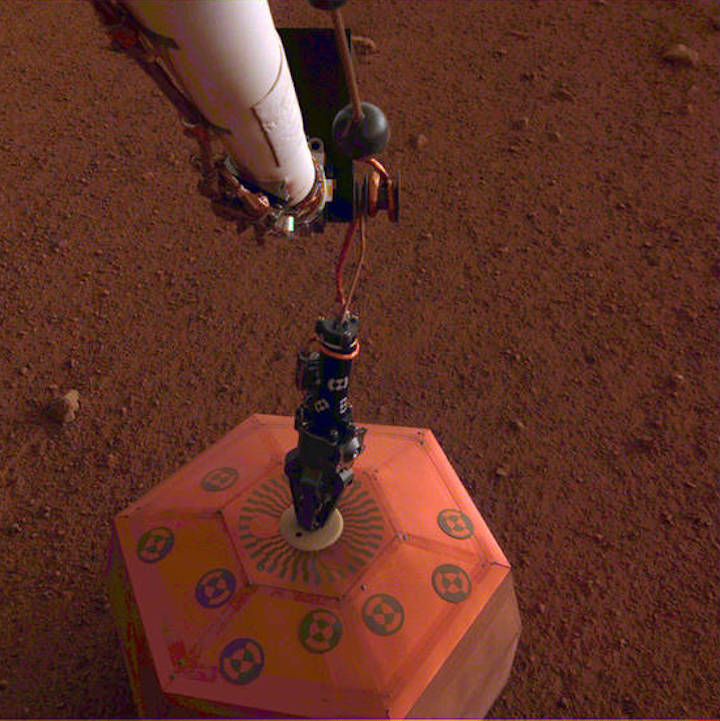
NASA's InSight lander has deployed its first instrument onto the surface of Mars, completing a major mission milestone. New images from the lander show the seismometer on the ground, its copper-colored covering faintly illuminated in the Martian dusk. It looks as if all is calm and all is bright for InSight, heading into the end of the year.
"InSight's timetable of activities on Mars has gone better than we hoped," said InSight Project Manager Tom Hoffman, who is based at NASA's Jet Propulsion Laboratory in Pasadena, California. "Getting the seismometer safely on the ground is an awesome Christmas present."
The InSight team has been working carefully toward deploying its two dedicated science instruments onto Martian soil since landing on Mars on Nov. 26. Meanwhile, the Rotation and Interior Structure Experiment (RISE), which does not have its own separate instrument, has already begun using InSight's radio connection with Earth to collect preliminary data on the planet’s core. Not enough time has elapsed for scientists to deduce what they want to know — scientists estimate they might have some results starting in about a year.
To deploy the seismometer (also known as the Seismic Experiment for Interior Structure, or SEIS) and the heat probe (also known as the Heat Flow and Physical Properties Probe, or HP3), engineers first had to verify the robotic arm that picks up and places InSight's instruments onto the Martian surface was working properly. Engineers tested the commands for the lander, making sure a model in the test bed at JPL deployed the instruments exactly as intended. Scientists also had to analyze images of the Martian terrain around the lander to figure out the best places to deploy the instruments.
On Tuesday, Dec. 18, InSight engineers sent up the commands to the spacecraft. On Wednesday, Dec. 19, the seismometer was gently placed onto the ground directly in front of the lander, about as far away as the arm can reach — 5.367 feet, or 1.636 meters, away).
"Seismometer deployment is as important as landing InSight on Mars," said InSight Principal Investigator Bruce Banerdt, also based at JPL. "The seismometer is the highest-priority instrument on InSight: We need it in order to complete about three-quarters of our science objectives."
The seismometer allows scientists to peer into the Martian interior by studying ground motion — also known as marsquakes. Each marsquake acts as a kind of flashbulb that illuminates the structure of the planet's interior. By analyzing how seismic waves pass through the layers of the planet, scientists can deduce the depth and composition of these layers.
"Having the seismometer on the ground is like holding a phone up to your ear," said Philippe Lognonné, principal investigator of SEIS from Institut de Physique du Globe de Paris (IPGP) and Paris Diderot University. "We're thrilled that we're now in the best position to listen to all the seismic waves from below Mars' surface and from its deep interior."
In the coming days, the InSight team will work on leveling the seismometer, which is sitting on ground that is tilted 2 to 3 degrees. The first seismometer science data should begin to flow back to Earth after the seismometer is in the right position.
But engineers and scientists at JPL, the French national space agency Centre National d'Études Spatiales (CNES) and other institutions affiliated with the SEIS team will need several additional weeks to make sure the returned data are as clear as possible. For one thing, they will check and possibly adjust the seismometer's long, wire-lined tether to minimize noise that could travel along it to the seismometer. Then, in early January, engineers expect to command the robotic arm to place the Wind and Thermal Shield over the seismometer to stabilize the environment around the sensors.
Assuming that there are no unexpected issues, the InSight team plans to deploy the heat probe onto the Martian surface by late January. HP3 will be on the east side of the lander's work space, roughly the same distance away from the lander as the seismometer.
For now, though, the team is focusing on getting those first bits of seismic data (however noisy) back from the Martian surface.
"We look forward to popping some Champagne when we start to get data from InSight's seismometer on the ground," Banerdt added. "I have a bottle ready for the occasion."
JPL manages InSight for NASA's Science Mission Directorate in Washington. InSight is part of NASA's Discovery Program, which is managed by NASA's Marshall Space Flight Center in Huntsville, Alabama. Lockheed Martin Space in Denver built the InSight spacecraft, including its cruise stage and lander, and supports spacecraft operations for the mission.
A number of European partners, including CNES and the German Aerospace Center (DLR), support the InSight mission. CNES provided SEIS to NASA, with the principal investigator at IPGP. Significant contributions for SEIS came from IPGP, the Max Planck Institute for Solar System Research in Germany, the Swiss Institute of Technology in Switzerland, Imperial College and Oxford University in the United Kingdom, and JPL. DLR provided the Heat Flow and Physical Properties Package (HP3) instrument, with significant contributions from the Space Research Center of the Polish Academy of Sciences and Astronika in Poland. Spain's Centro de Astrobiología supplied the wind sensors.
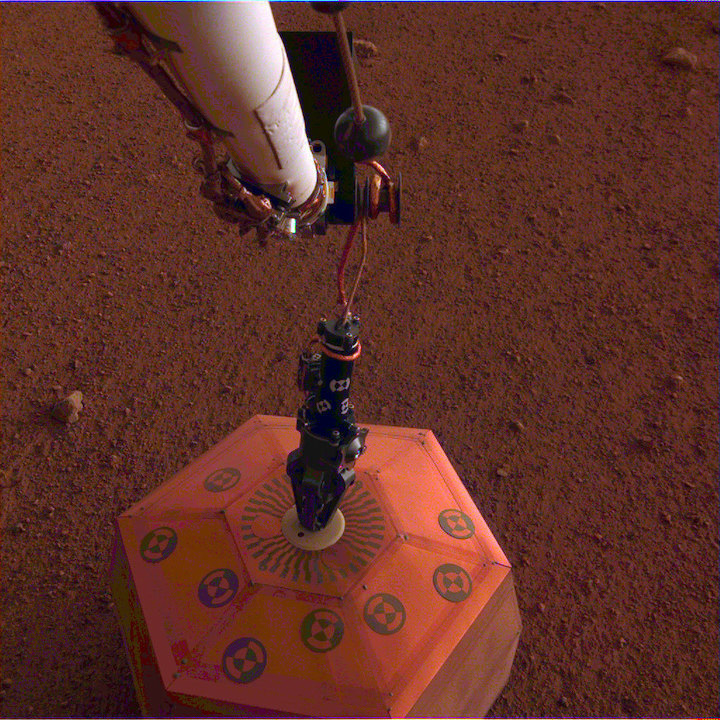
SEIS Deployed on Mars: NASA's InSight lander placed its seismometer on Mars on Dec. 19, 2018. This was the first time a science instrument had ever been placed onto the surface of another planet. Credit: NASA/JPL-Caltech
